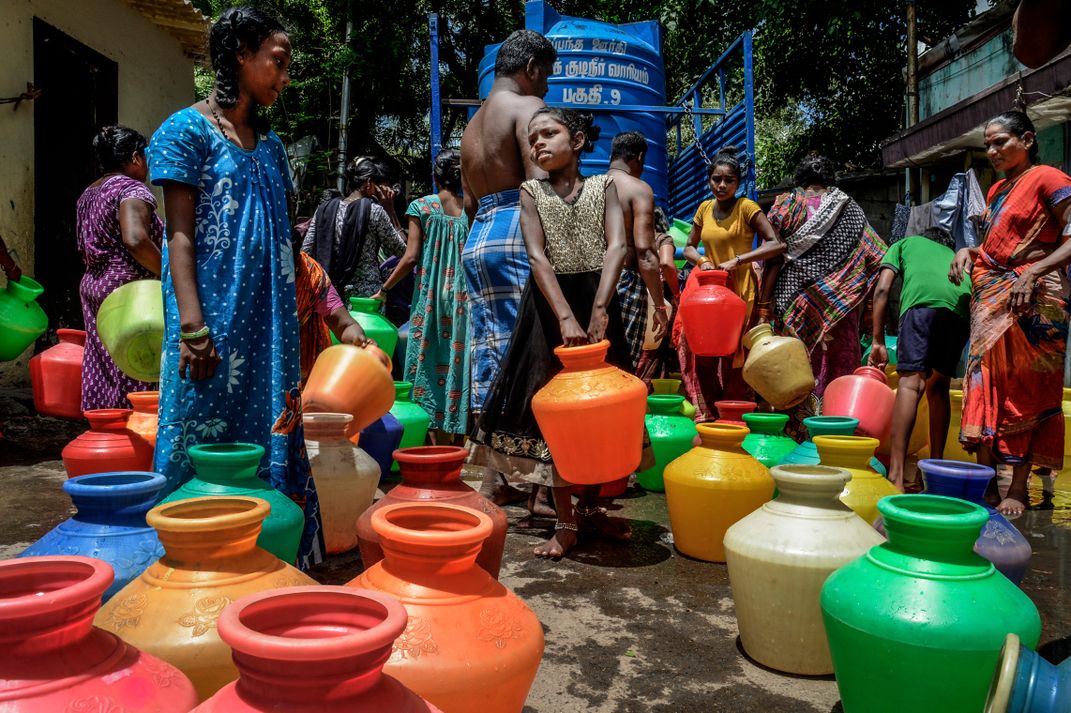Satellite Images Reveal the Extent of Chennai’s Water Shortage
Poor management, groundwater overuse and climate change-driven weather shifts are among the factors driving the crisis
/https://tf-cmsv2-smithsonianmag-media.s3.amazonaws.com/filer/f6/59/f659c277-2d0d-4353-babd-a7f3df73a882/chennai.gif)
A pair of photographs taken by NASA’s Operational Land Imager roughly a year apart offer a stark visualization of the water shortage currently plaguing Chennai, capital of the Indian state of Tamil Nadu. The first image, dating to May 31, 2018, shows the city’s primary rain-fed reservoir, Puzhal Lake, at roughly full capacity; the second, dating to June 19, 2019, renders that same landscape unrecognizable, revealing a parched swath of land with virtually empty reservoirs.
According to the Hindustan Times, Chennai’s four main reservoirs carry a maximum of 11,257 million cubic feet of water. As of June 21, however, the lakes contained just 23 million cubic feet—a mere 0.2 percent of their full capacity. In short, India’s sixth-largest city, home to an estimated 9 million people, is nearly out of water.
Describing conditions across the capital, NPR’s Sushmita Pathak writes that lines for water wrap around city blocks, while government tankers carry water to residential areas. (Recent media reports suggest Chennai is also turning to trains to transport water in from surrounding regions.) At hospitals, nursing homes and other public institutions, prices are rising to help cover the increased cost of water, and at local businesses, employees are being encouraged to work from home because there is no running water in office bathrooms. Per BBC News, many hotels and restaurants are at risk of shutting down due to the pervasive water shortage.

In some parts of the city, residents are digging wells as deep as 1,000 feet despite the fact that much of this groundwater is too dirty to drink and can only be used for washing. In other areas, according to CBS News’ Arshad R. Zargar, bucket-wielding locals queue outside of government trucks and, when these trucks fail to meet demand for water, resort to purchasing water from expensive private vendors. As NPR's Pathak notes, those living in Chennai’s poorest neighborhoods cannot afford private sellers’ exorbitantly priced water, leaving them wholly reliant on the government’s slim supply.
Although local administrators are taking steps to lessen the effects of the shortage—among others, asking neighboring states to funnel in water via pipelines and trains, commissioning plants to convert waste water for industrial use, and pledging to open two new desalination plants within the next five years—the crisis is far from over.
Toward the end of June, Edappadi K. Palaniswami, chief minister of the state of Tamil Nadu, said that the dry spell would likely continue through October or November, when India’s monsoon season— which is responsible for providing around 70 percent of the annual rainfall needed to meet the country’s agricultural and life-sustaining needs, according to Forbes’ Marshall Shepherd—is expected to replenish the city’s supplies with rainwater. Typically, monsoon conditions arrive in June, but as NPR’s Pathak explains, this year’s season is unusually delayed. Coupled with increasingly erratic rainfall and a severe heat wave, the belated monsoon season has had devastating consequences.
According to Earther’s Brian Kahn, Chennai’s current situation can be attributed to a number of factors, including poor management, overuse of groundwater and climate change-driven weather shifts. The Guardian’s Amrit Dhillon further notes that urban development has destroyed wetlands around the city, which relies largely on the monsoon to meet demand for water. When this season is late or inadequate, Dhillon writes, there are “no policies in place to compensate for the shortfall.”
Speaking with Earther, Raj Bhagat, the World Resources Institute’s sustainable cities manager in India, says, “The issue plaguing Chennai is a mix of over consumption and low rainfall during 2018 North East Monsoon,” which lasted from October to December of last year.
Bhagat continues, “The city and its neighbouring region has witnessed massive growth in all sectors over the last century, which had resulted in massive [increases in water] consumption.”
In addition to supporting a rapidly growing population, Chennai has become increasingly urbanized, depleting options for obtaining groundwater via permeable surfaces. And even at maximum capacity, Kahn explains, the city’s reservoirs carry much less water than needed.
“This was not a sudden, apocalyptic thing,” G. Yogesh, a 31-year-old who works for one of Chennai’s information-technology firms, tells the Washington Post’s Niha Masih and Joanna Slater.
He adds, “This is the result of slow degradation” linked with inadequate political will and public ignorance, concluding, “There is only one backup plan—to leave the city.”
The water shortage isn’t simply affecting Chennai: According to a Central Water Commission assessment summarized by News18, 65 percent of India’s reservoirs are running dry, with 59 out of 91 reporting below-normal water levels. Per a 2018 report by Niti Aayog, a government policy think tank, 600 million people across India face high to extreme water shortages. Just one fourth of households have drinking water at home, and some 200,000 die annually due to inadequate supplies or water contamination.
To better manage local water supply, Bhagat suggests investing in infrastructure strategies such as harvesting more rainwater, launching a water reuse program, improving irrigation efficiency to ensure more water ends up in reservoirs, and conserving flood plains and lakes.
Jyoti Sharma, founder and president of FORCE, an Indian NGO working on water conservation, paints a stark picture of the crisis in an interview with CNN’s Jessie Yeung, Helen Regan and Swati Gupta.
“Unless we adapt our water storage to suit the change in rain intensity, we're going to suffer really badly,” Sharma concludes. “All parts of India—rural, urban, everybody.”
/https://tf-cmsv2-smithsonianmag-media.s3.amazonaws.com/accounts/headshot/mellon.png)
/https://tf-cmsv2-smithsonianmag-media.s3.amazonaws.com/accounts/headshot/mellon.png)